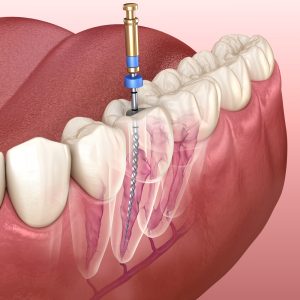A root canal treatment is an endodontic procedure used to save a tooth when it has become infected. Cavities are routinely treated with dental fillings, but when the infection reaches the tooth pulp, the sensitive area inside a tooth where the nerves and blood vessels are located, a root canal will be needed to clear it out. The procedure consists of accessing the inside of the tooth, removing the decayed pulp, cleaning the root canal, and refilling the space with a biocompatible material. The tooth is usually then sealed with a dental crown to protect it and restore it to full function.
dental fillings, but when the infection reaches the tooth pulp, the sensitive area inside a tooth where the nerves and blood vessels are located, a root canal will be needed to clear it out. The procedure consists of accessing the inside of the tooth, removing the decayed pulp, cleaning the root canal, and refilling the space with a biocompatible material. The tooth is usually then sealed with a dental crown to protect it and restore it to full function.
Many patients are intimidated by the idea of going through this procedure because they may have heard some common myths associated with it. The fact is, it is preferable to the alternative of having the tooth extracted. Here are a few myths debunked about root canals.
Root canal treatments are very painful.
Anesthesia is administered at the beginning of the procedure, so the patient experiences little to no pain. Additionally, advancements made in the field of endodontics have improved patient comfort. The infected pulp is the cause of the pain anyway, and as the goal of the treatment is to remove it, it basically removes the source of the pain. Some sensitivity or irritation may be felt after the anesthesia wears off, but this can be relieved with over-the-counter or prescription medications.
Tooth extraction is a better alternative to a root canal.
Dentists generally aim to preserve the natural tooth as often as they can, rather than extract it and replace it with a prosthetic. Natural teeth are stronger than any dental replacement and provide much better function. It is also more cost-effective to have a root canal done as there would be additional costs required to get a tooth replacement, such as a dental implant.
Root canals require several visits to the dentist office.
It can take several visits, but, depending on the condition of the infection, a root canal can be completed in as little as one appointment.
A root canal is not needed for a dead tooth.
Even if there is no longer any pain or sensitivity felt after a tooth has died, bacteria can still be multiplying inside it. It could spread to the surrounding bone, requiring more complicated and costly treatment. A root canal will not only save the tooth but protect the surrounding structures in the mouth.
Root canals are not very effective.
This treatment has a success rate of almost 95 percent. In any case, it is better to try to save the tooth first before having it extracted.